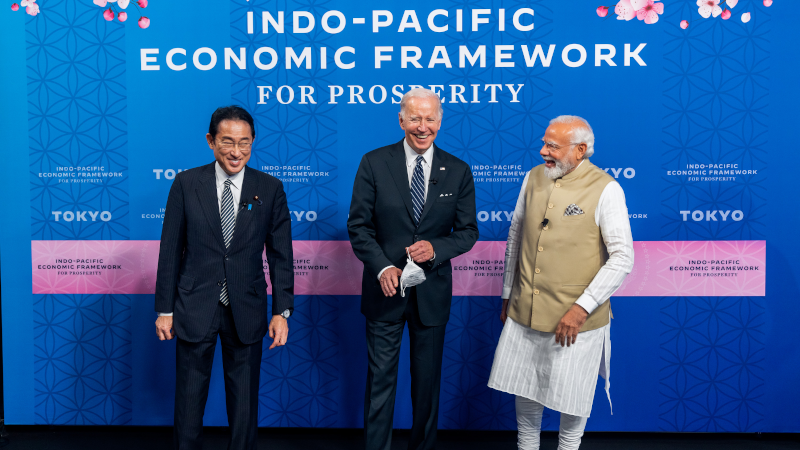Navigating the Geopolitical Waves In The Indian Ocean: India’s Strategic Maneuvering – OpEd

The Indian Ocean has emerged as one of the strategic regions of contest where India, China and the US are involved in a power struggle. This is why India has to navigate between two giants while pursuing its regional dominance in this strategically and economically vital region. The US supports the “Free and Open Indo-Pacific Strategy”, China supports the “Belt and Road Initiative (BRI)” and India supports the “Security and Growth for All in the Region (SAGAR). ” These differences in strategies are due to the competitive nature of the region and thus, the outcomes and the balance of power are different.
The US strategy in the Indian Ocean Region (IOR) continues the Asia-Pacific strategy, which is designed to challenge China’s hegemony. This view perceives India as a strategic and economic ally to counterbalance China. This vision is reflected in the Indo-Pacific concept that promotes the U. S. cooperation with Quad members, Japan, Australia, and especially India to contain China’s influence through the Malacca Strait. This geopolitical positioning of the two countries shows why a strong US -India strategic relationship is important.
Over the last few years, the US has ramped up its naval power projection in the IOR and has conducted more naval exercises with India. Malabar naval exercise in 2023 involved all Quad members, which showed improved military cooperation among the group. The U.S has also declared new infrastructure funding for projects in the Indo-Pacific region to challenge China’s BRI to offer options for development.
India is eager to enhance its relations with the U. S. due to the mutual strategic, economic, and political interests. However, the two nations have different priorities of their partnership; India is more interested in economic power in the Indian Ocean region while the US is interested in military power and freedom of navigation. The US Indo-Pacific Strategy may be threatened as China seizes the cracks in the region, consolidates its partnership with Pakistan, and uses its economic might to gain political power. In order to effectively balance China, the U.S needs to increase its non-military capabilities and diplomacy, thus implementing a multi-faceted regional strategy.
For China, the IOR is important on both strategic and economic fronts, connecting it to other Asian markets and furthering its Maritime Silk Road. China has committed more than $10 billion for port development projects in the IOR in 2022, Sri Lanka and Djibouti included. China and India are two countries that have emphasized the commercial and trade aspects in their regional policies. However, China’s ally in the region, Pakistan, and especially the CPEC project, pose a challenge to India’s influence in the region. The strengthening of the China-Pakistan relations poses an economic threat to India thereby forcing it to support the US regional agenda.
India’s apprehensions are not restricted to the Indian Ocean but are more to do with the strategic partnership between China and Pakistan. The CPEC being one of the major projects of the BRI directly poses a threat to India’s regional dominance and economic dreams. This dynamic forces India to build up its strategic relations within the Quad, using its economic and strategic strength to check China’s moves in the region.
To navigate the Sino-US rivalry in the region, India has to tread cautiously, and the best strategy is to preserve the status quo in the region. The change of emphasis from the Indian Navy’s anti-China approach in the 1990s to modern Quad cooperation highlights India’s new role in the region. India’s SAGAR doctrine shows that it is active in the region, but rising tensions with China require better relations with Quad members to support India’s goals and to counteract China’s aggression.
It is therefore important that the management of this changing security environment is well addressed for the stability of the region and the interest of the United States of America. The US presence as a balancing power can be helpful for regional stability, although Biden’s approach is focused on the “soft power” to counterbalance the anti-China stance. This subtlety is different from the Trump administration’s approach, indicating that India needs to increase its position in the Quad. India’s call to Australia to join the Malabar exercises during the Ladakh standoff is a perfect example of how it is rallying regional partners against a common foe in China.
India also needs to guarantee that the Indo-Pacific continues to be a key part of America’s strategic vision, which creates a context for India to project power in the region. In the changing regional context, India’s optimal strategy is to balance the two contending hegemons, the US and China, and use their conflicting views to increase its freedom of maneuver. The future of the region will depend on how President Biden will manage these factors, and his focus on allies as an essential strength, which prompts questions about the region’s development. The Modi-Trump combination enabled India to respond to China’s actions adequately; however, the change in the US presidency may pose new threats and opportunities.
In conclusion, India's strategic maneuvering in the Indian Ocean will be crucial in shaping the region's future. By balancing its relationships with the US and China and leveraging its role within the Quad, India can enhance its regional leadership and safeguard its interests amid the great power competition.
